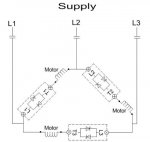Question, are the smaller feeders coming of the main for a fire pump? Normally I would assume parallel but I'm confused.
this is the pull box before the meter.
the calcs call for parallel big conductors [dont remember... 750mcms?]
=> two pipes were supplied
original crew only pulled one set
i complained about the voltage and they [first refused and then] pulled new conductors
And a new upsized xfmr bank!!!!
the set in the photo is the original wire pull, the pipe on the left are the new , smaller wires
now that you mention it, i remember that , in parallel conductors, they say
if the resistance is mismatched because of size or length, most all the current will flow on the bigger/shorter wire.
So maybe the smaller wires are doing absolutely nothing! Well that would explain a lot hmmm...
got to go back, again
make more detailed measurements
L-N [3X]
amp flow on individual conductors in the parallel pairs
the powersight 3000's quickest sample rate is 1 second - it really didn't capture the voltage changes that well
i'll check to see which of my meters has the fastest sampling rate, but those klein clamps did just fine- just like a regular multimeter
went as low as 187v instantaneous with the building very lightly loaded


